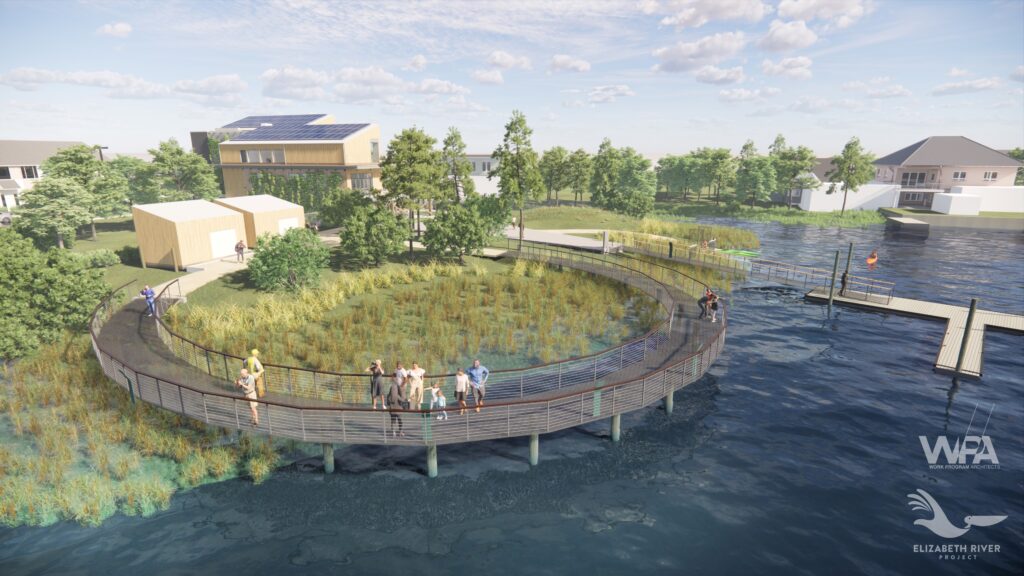
The non-profit Elizabeth River Project (ERP) aims to preserve and protect the health of the Elizabeth River and its tributaries. For architect Sam Bowling, AIA, of Work Program Architects (WPA) in Norfolk, they’re a dream client that aligns with his passion for sustainable and resilient design, which he’s fostered since his architecture school at Kansas State University. In what he calls “the opportunity of his career,” Bowling worked as the lead architect on the design of the Pru and Louis Ryan Resilience Lab for ERP—an $8 million model for urban coastal living amid sea level rise.
The public’s impression of the Elizabeth River was that it was a dead river, unsafe for swimming and they simply wanted to just write it off. But ERP believed they could change that. Starting with a grassroots approach doing shoreline and river restorations, they’ve developed a repertoire of different programs that they work through–the design, construction, and implementation of living shorelines–a key feature of the Pru and Louis Ryan Resilience Lab. They even have programs for homeowners to help them figure out cost-sharing and obtaining grant money.
One of the things that WPA is known for is collaborative design work. The initial plan was to renovate-in-place a one-story, concrete block American Legion Post on a unique urban waterfront site along Colley Avenue. By the end of the first client meeting, the design team realized there was no way to fit all of the project’s ambitions and goals into the existing building, and that it was time to start thinking about a new building that would allow ERP to be a bigger leader in their field.

With the help of Hampton University’s architecture students, we hosted a week-long group design session in which city council members, donors, and city employees participated. Ultimately, we came up with a series of goals for the project that helped define the design of the building going forward. We agreed it should be more than just an office building; it had to be a teaching tool; it had to be a good example of sustainability and resilience in a coastal environment; it had to inspire people and explain itself to the average passerby. As design progressed during the pandemic, we continued to have stakeholder meetings, which were expanded to include Norfolk State and other higher education groups that wanted to participate and install research projects on the future site.
The building and site take a few novel approaches to achieving the mission goals – and appealing to the target audience of homeowners and small businesses. The building is built like a “beach house”: wood-framed, using plywood sheathing, fiberglass insulation, and residential style windows in order to show how people can create a resilient, net-zero, water-reusing building out of off-the-shelf building materials. The entire project site – every surface – is designed to percolate and absorb water and let it naturally work its way back into groundwater and eventually the river. The project accomplishes this without using conventional stormwater management systems, like underground concrete pipes. Instead, the whole site works like a sponge to soak up rain and flood water. The parking lots, for instance, are a pervious paving system with a gravel filter layer underneath and will pre-filter and pre-treat the water to reduce the number of pollutants washed into the river. The site is a series of bioswales, where the natural landscape captures the water and moves it into areas when it can then percolate into the soil at its own speed. Knowing that heavy rain events and Nor’easters are what cause a lot of the local “nuisance” flooding, the goal was for all storm water to be handled by the site in a completely natural and passive way.
Additionally, the living shoreline works as a barrier to erosion from flooding along the river’s edge. The whole site is built to be flooded, including on-site storage buildings. Two storage sheds will be built: one elevated above the floodplain, and the other built on a floating platform that will ride out flooding. There is a floating research dock, as well as the Boardwalk Observatory–a semi-circular structure that reaches from the site, over the shoreline, into the river itself and then loops back in. It will be a publicly accessible path with the objective to give visitors a new perspective of the coastline. Being able to get out over the water, look back at the shoreline, and experience a piece of Norfolk from that perspective is unique. The Boardwalk is made of marine fiberglass–it won’t rust, it won’t ever decay, it doesn’t leach chemicals into the water over time, nor does it need to be treated over time, like wood. The walking surface is open grating, so the sun can penetrate through it and not shade the wetlands and cause dead spots. Visitors will also be able to look past their feet and see the plants, the grass, the fish, the snails and crabs–see and understand the ecology that’s being created there first-hand.
This project was a dream come true in the sense rather than having to convince the clients to do bare minimum, it was ERP and WPA actively pushing each other throughout the process to come up with more audacious solutions and clever ways to solve problems.
This interview has been edited for length and clarity.
Team Three is an editorial and creative consultancy based in Washington, DC.
